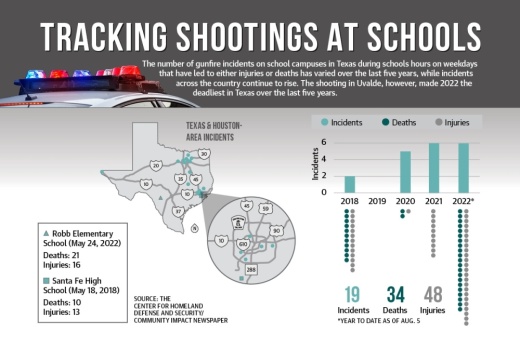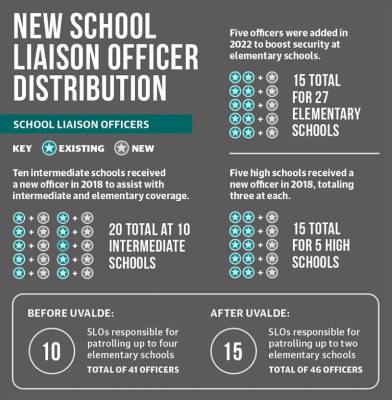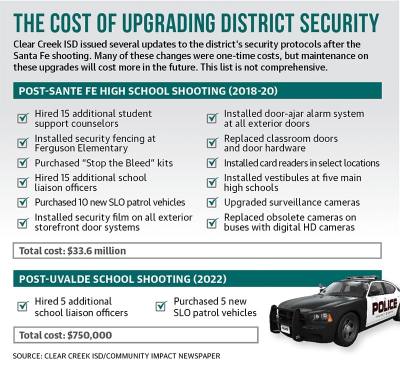The efforts came into the spotlight after the May 24 shooting and the Texas Education Agency issuing in late June a series of mandates to be completed before the start of the 2022-23 school year.
“Clear Creek ISD has no more important responsibility than promoting the safety of students, staff and all members of the community,” Superintendent Eric Williams said during a July 11 presentation of school safety recommendations for the district.
Some of the requirements set by the TEA and the Texas School Safety Center include completing a summer safety audit with about 50 questions to be considered for each instructional facility in the district, completing a comprehensive exterior door safety audit, training all campus staff and scheduling mandatory drills for the school year.
CCISD employs more than 5,000 people and teaches more than 40,000 students. The process of completing the mandates issued by the state was “intense,” said Brian Palazzi, the director of CCISD’s Safe Schools Department.
“It was a lot, but it was essential,” he said. “We couldn’t have gotten this done without collaboration between [multiple] departments.”
Meanwhile, the state announced it will allocate $105.6 million to support school safety and mental health initiatives for districts across the state through Aug. 31, 2023. The funds will be transferred to individual state agencies, which will then be tasked with distributing each district’s share of $17.1 million as needed, TEA Senior Media Coordinator Melissa Holmes said.
“This additional financial support is not the end as the Legislature will continue to prioritize these initiatives during the next budget cycle,” said state Sen. Joan Huffman, R-Houston, who serves as chair of the Senate Finance Committee, in a news release.
Post-Uvalde response
CCISD formed a committee over the summer dedicated to reviewing the state of district safety and recommending actions to the board of trustees. The committee consists of 44 members and includes 20 parents.
In July meetings, leading members of the committee Palazzi and Assistant Superintendent of Support Services Paul Miller presented recommendations to the board of trustees. Key ideas presented included improving technology and security systems and adding school security staffing.
New door-ajar alarms were installed on all schools’ exterior doors over the summer, Chief Communications Officer Elaina Polsen said.
Palazzi said all doors besides the main entrance are locked during school hours, and all visitors must enter through the main entrance.
“Years ago—let’s take a high school, for example—you got to the school, [and] all the doors were open; people just kind of came in from wherever they wanted to be,” Palazzi said.
To bolster school security staffing, the board of trustees finalized an agreement July 25 with the Galveston County Sheriff’s Office to add five additional school liaison officers to elementary schools. The district now has access to 46 total officers.
Hiring the new officers allows for the now 15 elementary officers to patrol no more than two schools, Palazzi said.
To further bolster security at elementary schools, the district will officially re-establish its Watch D.O.G.S.—or Dads of Great Students—volunteer parent program, which was put on hold due to COVID-19. Watch D.O.G.S. is a national program that allows for father figures and other volunteer adults in the district to have a presence on campus and assist in some school operations, primarily elementary schools.
A new online training course for Watch D.O.G.S. volunteers was finalized Aug. 5, Polsen said. The training incorporates the district’s standard response protocol for active shooter situations while also going into student behavioral health and how to identify students in need of support.
“There’ll be some additional support provided to schools in soliciting volunteers explaining what their role is ... and then certainly recognizing these heroes along the way and, hopefully, [garnering] some additional support,” Polsen said.
Changes since Santa Fe
After the Santa Fe High School shooting in May 2018, the school safety department made a series of recommendations to the board, including hardening facilities and adding additional security and counseling staff.
To harden facilities and replace obsolete systems, the district spent $29.9 million from a $487 million 2017 bond program on various upgrades, including installing secured vestibules at five of its high school campuses, upgrading locks at all classroom doors, upgrading cameras and surveillance technology, and adding panic buttons on all phones, Miller said.
The district added 15 school liaison officers after Santa Fe, totaling 41 officers at the time, according to a June 28 Safe and Secure presentation. One was added to each of the five main high school campuses and to each of the intermediate schools, costing $1.2 million annually from the district’s general fund, Miller said.
Additionally, 15 new student support counselors were added to the district in 2018: one to each main high school and intermediate school and some added to select elementary schools, according to the Safe and Secure presentation. The new counselors cost $975,000 annually from the general fund, Miller said.
The COVID-19 pandemic hindered the safety department’s work, forcing the group to focus its efforts on safely reopening schools and implementing pandemic response protocols, Miller said in the presentation. He said the Uvalde shooting prompted the committee to refocus on its initial goals.
“Many of [the concerns from the School Safety Committee], there was either not enough funding to do, or they just didn’t make sense at the time, but it may make sense now,” he said.
Future of school safety
The five new officers hired by the district are undergoing their training process, which will take four to five months, board President Jay Cunningham said.
The cost of the new officers is estimated to be $425,000 per year out of the district’s regular budget. The five new vehicles for the officers and their equipment will be paid for by $200,000 of capital and contingency funds, Miller said.
Additionally, a districtwide community safety hotline will be implemented in the upcoming fall semester. The district will communicate to staff and students as people return to schools to dial 281-284-0911 if the community witnesses a “true emergency” on or near campuses from 7 a.m. to 5 p.m., Palazzi said. After hours, he encouraged people to call 911.
Polsen also encouraged everyone in the district to download the anonymous CCISD Alerts app. She said instructions to contact officials via the app or the safety hotline will be placed on gates outside elementary schools.
Meanwhile, the district is in the process of implementing exit door numbers on all exterior doors and window numbers and sharing the information with local law enforcement. Signs are also being created to place on perimeter gates outside of elementary schools signaling to notify officials via a hotline if a gate is left open.
In accordance with the TEA and standard procedure, various safety drills are scheduled for the coming semesters. Miller said each of the five drills takes place at least once a semester in addition to fire drills.
“We’ve been doing this long enough where these kiddos know exactly what’s happening. The substitutes get trained; every one of our operations staff gets trained,” Miller said. “If you train, you learn.”








